#black scoter
Explore tagged Tumblr posts
Text

Melanitta nigra [クロガモ,Black scoter]
港の中に入ってきていたクロガモの群れ。 20羽ほどいたのですが、♀は1羽で他は全部♂。
41 notes
·
View notes
Text
Round 1 match 6B


Redheads nest in wetlands, weaving their nests from tall vegetation so that they are suspended over the water. Redheads, like many other duck species, practice brood parasitism, where females lay their eggs in the nests of other females, thereby avoiding the energetic cost of incubating their own eggs. Redheads are especially known for this behaviour and will lay eggs in the nests of numerous other species, some of which are not even ducks!
Scoter ducklings are shrouded in mystery, and the Black Scoter is no exception. Photos of the ducklings are rare and hard to find. The ducklings, like other scoter ducklings, are dark all over, except for a white cheek patch. Black scoters nest on the ground near bodies of water, primarily in Quebec, Newfoundland and Labrador, and Alaska.
#redhead duck#black scoter#ducks#birds#baby duck poll#ducklings goslings cygnets#tumblr polls#tournament poll#round 1
2 notes
·
View notes
Text
Scoters at the Cape Cod Canal 02/02/25
0 notes
Text
BOTD: Black Scoter

Photo: Ashley M Bradford
"Was once called 'Common Scoter,' but that name is now restricted to a similar species in the Old World. The Black Scoter is generally seen less often than the other two kinds of scoters in most parts of North America. Floats rather buoyantly on water, often with tail cocked up noticeably. On northern waters, more vocal than the other two scoters, giving clear whistled calls."
- Audubon Field Guide
#birds#black scoter#birds of north america#north american birds#scoters#ducks#seaducks#waterfowl#birds of the us#birds of canada#birds of mexico#birding#bird watching#birdblr#birblr#bird of the day#Melanitta americana
40 notes
·
View notes
Text


2 notes
·
View notes
Text
Birds of the 13th (posted last minute lol)
Black scoter (Melanitta americana)



The oldest black scoter was a male, and he was at least 10 years and 6 months.
0 notes
Text

Thanks to the anonymous new Key West resident who called to report this Black Scoter down with a wing injury at Cow Key Channel Bridge. Thanks to Lazy Dog for making the rescue and transferring the patient into our care. The wing has been treated in our clinic.
8 notes
·
View notes
Text
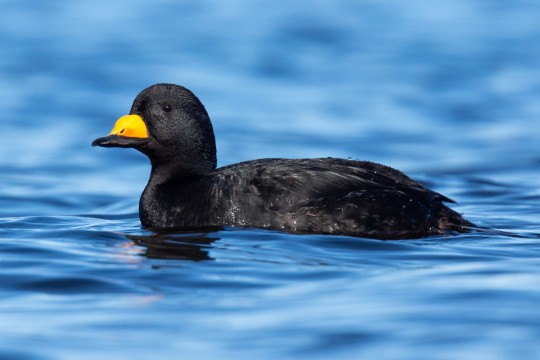
[863/10,977] Black Scoter - Melanitta americana
Order: Anseriformes Family: Anatidae (ducks, geese and swans) Subfamily: Anatinae (dabbling ducks)
Photo credit: David Turgeon via Macaulay Library
65 notes
·
View notes
Photo

Long-tailed ducks (top) and a black scoter (bottom) . . . Indian River Inlet, Delaware . . . 1/19/21
12 notes
·
View notes
Photo










The black scoter or American scoter (Melanitta americana) is a large sea duck, 17 to 19 inches in length. Its French name, used in parts of its Canadian range, is macreuse noire (also meaning "black scoter"). The species is listed as Near Threatened by the IUCN.
The genus name is derived from Ancient Greek melas "black" and netta "duck". The species name is from the Latin for "American ".
This large sea duck is characterised by its bulky shape and large bill. The male is all black with a very bulbous bill which is mostly yellow. The female is a brown bird with pale cheeks, very similar to female common scoter. The adult female averages about 980 g (2.16 lb) and 18 inches in length, while the adult male is on average 1,100 g (2.4 lb) and 19 inches in length. This species can be distinguished from other scoters, apart from common scoter, by the lack of white anywhere on the drake, and the more extensive pale areas on the female.
The black scoter breeds in the far north of North America in Labrador and Newfoundland to the southeast Hudson Bay. It also occurs on the Siberian side of the Bering Straits east of the Yana River. It winters farther south in temperate zones, on the coasts of the northern USA and Canada, on the Pacific coast south to the San Francisco Bay region and on the Atlantic and Gulf of Mexico coasts, and in Asia as far south as China. Some birds may over-winter on the Great Lakes. This species is a very rare vagrant to western Europe; only drakes are safely identifiable out of range, so females are likely to be undetected.
This species dives for crustaceans and molluscs while migrating or wintering on the sea-coasts, and feeds on insects and their larvae, especially caddisflies, fish eggs and, more rarely, vegetation such as duck weed while nesting on freshwater. It forms large flocks on suitable coastal waters in winter quarters. These are tightly packed, and the birds tend to take off together; in the breeding season they are less social. It has been suggested that in coastal waters this species prefers sheltered embayments, and possibly waters that include some mixed depths.
The lined nest is built on the ground close to the sea, lakes or rivers, in woodland or tundra. 5–7 eggs are laid. Each eggs weighs from 60–74 g, or 8% of the females body weight. The incubation period may range from 27 to 31 days. Females brood their young extensively for about 3 weeks, after which the still flightless young must fend for themselves.
#black scoter#melanitta americana#american scoter#macreuse noire#ducks#sea ducks#waterfowl#black birds#squawktober
54 notes
·
View notes
Photo
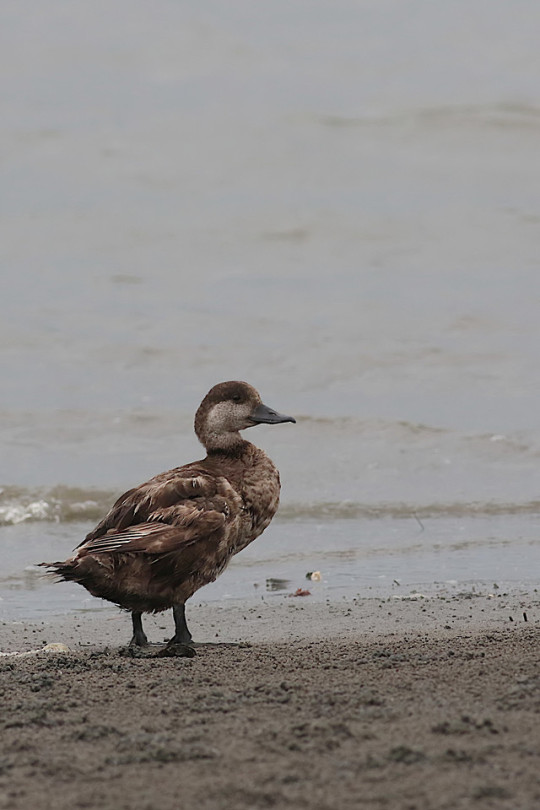
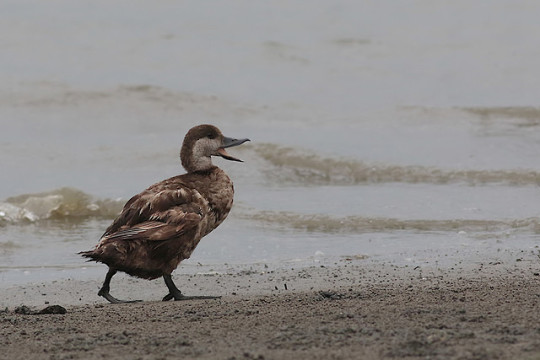
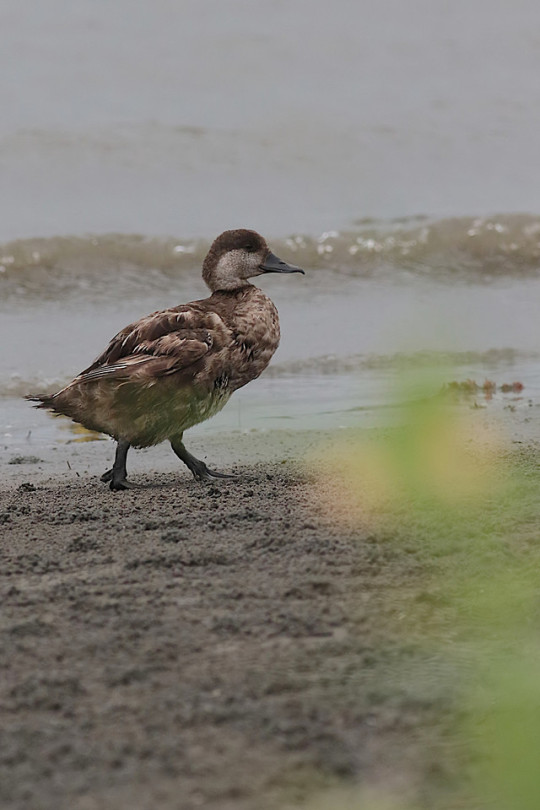
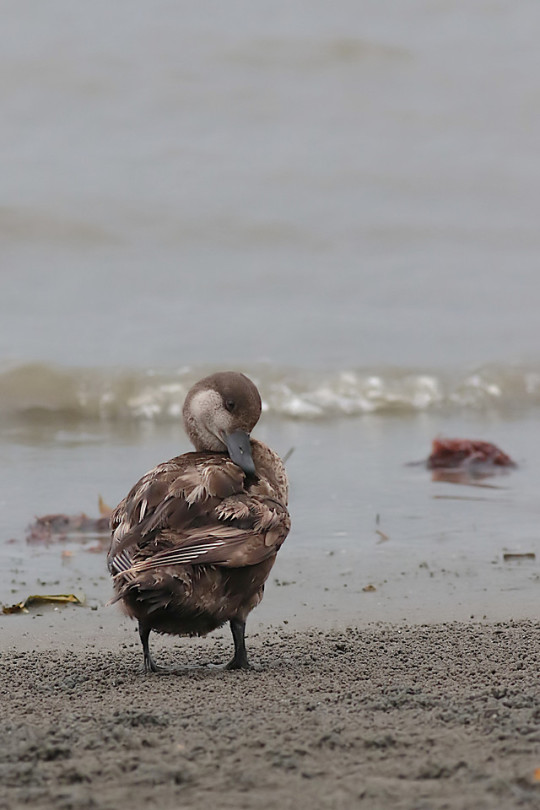
Melanitta nigra [クロガモ,Black scoter]
コシジロウズラシギのいる干潟に見慣れないカモがいたので、隣で撮っていたカメラマンに尋ねてみると「クロガモの雌だよ」と教えていただきました。
冬鳥のはずなのに、この子は越夏しているそうです。
少しづつにじり寄るように撮影。
かわいい顔してますね~(^O^)
8月中旬撮影
73 notes
·
View notes
Text
Round 1 match 1B


The Black Scoter is sexually dimorphic, meaning the females look different from the males. Females are dark brown all over except for their face and throat which are light. The Black Scoter is a sea duck, which means it spends much of its time in ocean waters, and can be found in the winter along both the Pacific and Atlantic coasts. This does not, however, mean that they avoid freshwater entirely. They often make their nests near freshwater, and some birds even winter on the Great Lakes.
The Mottled Duck is slightly sexually dimorphic, which means that while females and males may look different, these differences are very subtle. The primary difference is bill colour. Females have orange bills with black markings. Female Mottled Ducks look very similar to female Mallards, but the Mottled Duck can be identified by the presence of a black spot at the corner of its mouth where the top jaw and bottom jaw meet (called the gape).
#black scoter#mottled duck#ducks#female duck poll#hens pens and geese#tumblr polls#round 1#tournament poll
3 notes
·
View notes
Text
Black Scoter at the Cape Cod Canal 12/30/23

View On WordPress
1 note
·
View note
Photo


Black Scoter (female) Brooklyn Bridge Park, Pier 4 This beautiful female Black Scoter clocked in yesterday as my 158th species in Brooklyn Bridge Park! Thanks to @newyorknaturalist for the tip!
#scoter#black scoter#ducks#duck#birds#birdstagram#birding#birdwatching#ebird#brooklyn#nyc#brooklynbridgepark#brooklynheights#brooklynbridgebirds#birdfreaks#nuts_about_birds#urbanbirding#patchbirding#citizen science#nature#nycnature#birdnerds#citybirds
87 notes
·
View notes
Photo







ALL THREE SCOTERS IN ONE DAY
The black scoter and surf scoter are lifers. The juveniles are somewhat difficult to identify. I am still searching for adult males (with coloured beaks) of these 2 birds. All scoters are uncommon on inland waters. They prefer wintering on open salt water. I see the white-winged scoter frequently in west Toronto, Burlington and Hamilton.
black scoter, surf scoter, white-winged scoter
0 notes


